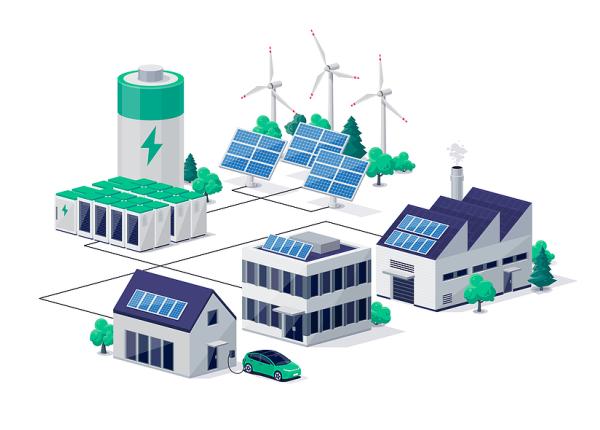Distributed Energy Storage
Distributed Energy Storage is a crucial component in the transition to a cleaner, more resilient energy system. By storing energy locally and using it when needed, we can reduce reliance on large, centralized power plants and better integrate renewable energy sources.

job openings
View open jobs in this Solution
Example Companies
- ConnectDER - ConnectDER make products that integrate power and data from residential scale DERs into the grid.
- Swell Energy - Swell Energy is a home energy company that provides smart grid and energy management solutions for homeowners and businesses.
- RedEarth Energy Storage - RedEarth Energy Storage is a professional energy storage company that offers systems to suit every client
- Cygni Energy - Cygni Energy is a manufacturer of energy storage devices for commercial and institutional customers.
- Span - Smart electrical panels to enable homes to get clean energy, faster, cheaper, and more easily.
- Tesla - Powerwall for home energy storage
- Stem - AI-driven energy storage solutions
- Fluence - Advanced energy storage technology and services
- sonnen - Residential and commercial energy storage systems
- Enphase - Integrated solar and storage solutions
Community
- Join DER Task Force on Slack
- Participate in Energy Storage Association events and working groups
Resources
- Intercalation Station - A battery-specific newsletter
- InDERmediate podcast - Move up your clean energy knowledge from beginner to intermediate level
- Energy Storage News - Latest updates in energy storage technology and markets
- DER Reading Guide - Comprehensive study material on Distributed Energy Resources
Overview
Distributed Energy Storage systems allow for the local storage and use of energy, reducing the need for large, centralized power plants that emit greenhouse gases. These systems play a crucial role in integrating renewable energy sources and improving grid stability.
Solutions by Sector
Residential
- Home Battery Systems: Devices like Tesla's Powerwall and LG Chem's RESU store solar energy for use during peak times or outages.
- Smart Home Integration: Systems that integrate with home automation to optimize energy use and storage.
Commercial and Industrial
- On-Site Energy Storage: Large-scale battery systems for businesses to manage energy use and reduce peak demand charges.
- Microgrids: Localized grids that can operate independently from the main grid, providing resilience and stability.
Utility-Scale
- Grid-Scale Batteries: Large installations like those by Fluence and Tesla that provide grid services such as frequency regulation and load balancing.
- Pumped Hydro Storage: Using excess energy to pump water uphill, which can be released to generate electricity when needed.
Progress Made
Significant advancements have been made in distributed energy storage:
- Lithium-ion Battery Improvements: Increased efficiency and reduced costs have made large-scale energy storage more viable.
- Smart Grid Integration: Advanced software and control systems allow for better coordination between storage systems and the grid.
- Renewable Energy Coupling: Improved integration of storage with solar PV and wind power systems.
- Vehicle-to-Grid (V2G) Technology: Electric vehicles are being used as mobile energy storage units, providing grid services when not in use.
Case Studies
- Hornsdale Power Reserve, Australia: Known as the "Tesla Big Battery," this project has significantly improved grid stability and reduced energy costs in South Australia (Tesla).
- Brooklyn Microgrid, USA: A community microgrid project that allows residents to trade solar energy locally, enhancing energy resilience and sustainability (LO3 Energy).
Lessons Learned
- Importance of Policy Support: Supportive policies and regulations are crucial for the widespread adoption of distributed energy storage.
- Value Stacking: Maximizing the value of storage systems by providing multiple services (e.g., peak shaving, frequency regulation, backup power).
- Locational Benefits: Proper siting of storage systems can provide significant grid benefits and defer costly infrastructure upgrades.
- Safety Considerations: Ensuring proper safety protocols and standards for battery storage systems, especially in residential settings.
Challenges Ahead
- Cost Reduction: While prices have decreased, further cost reductions are needed for widespread adoption.
- Long-Duration Storage: Developing cost-effective solutions for storing energy over longer periods (days to weeks).
- Raw Material Supply: Ensuring a sustainable and ethical supply chain for battery materials.
- Recycling Infrastructure: Developing efficient recycling processes for end-of-life batteries.
Best Path Forward
To accelerate the adoption and impact of distributed energy storage:
- Continued R&D Investment: Focus on improving energy density, longevity, and new storage technologies.
- Supportive Policies: Governments should implement policies that recognize the full value of energy storage, including grid services and environmental benefits.
- Standardization: Develop industry-wide standards for performance, safety, and interoperability.
- Workforce Development: Invest in training programs to build a skilled workforce for installation and maintenance of storage systems.
- Community Engagement: Educate the public about the benefits of distributed energy storage and its role in the clean energy transition.
Learn More
Image credit: Synapse Energy